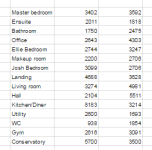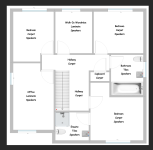Soldato
Hi all,
Buying a new build house and we're looking to put recessed spotlights in every room in the new house but am a bit baffled about how many we need.
All of the guides I've found on working it out says to take the square footage and times by 1.5 to get the total wattage and then to divide by the wattage of the bulbs.
Based on a 14x8 foot room that says we need 3. I've been in the room and 3 will not cut it.
Here are the rooms (in mm):

Here are some rough plans that I drew up:
Upstairs

Downstairs

Any help is greatly appreciated.
Thanks,
Andy
Buying a new build house and we're looking to put recessed spotlights in every room in the new house but am a bit baffled about how many we need.
All of the guides I've found on working it out says to take the square footage and times by 1.5 to get the total wattage and then to divide by the wattage of the bulbs.
Based on a 14x8 foot room that says we need 3. I've been in the room and 3 will not cut it.
Here are the rooms (in mm):

Here are some rough plans that I drew up:
Upstairs

Downstairs

Any help is greatly appreciated.
Thanks,
Andy
Last edited:



